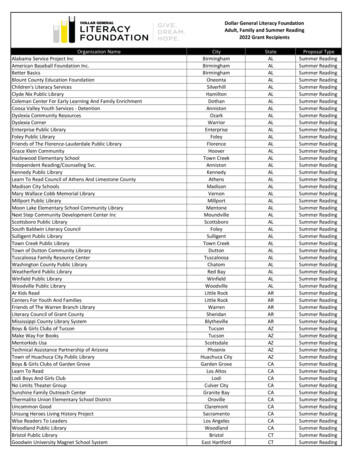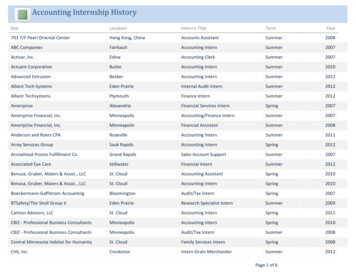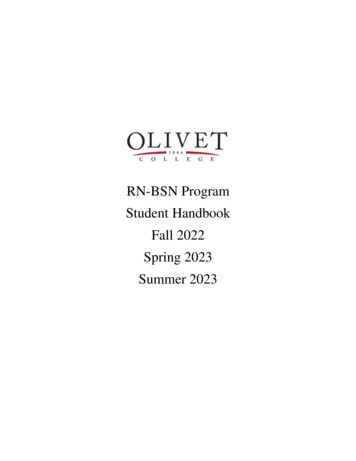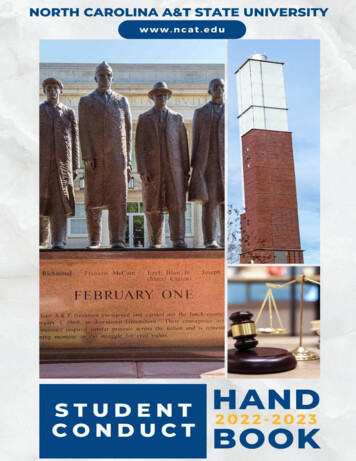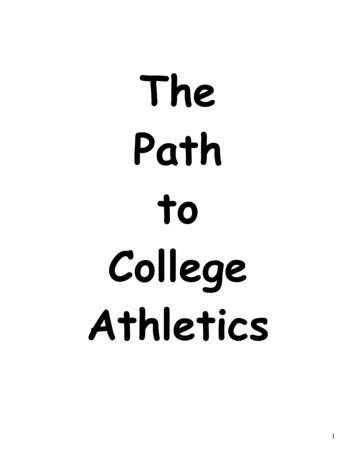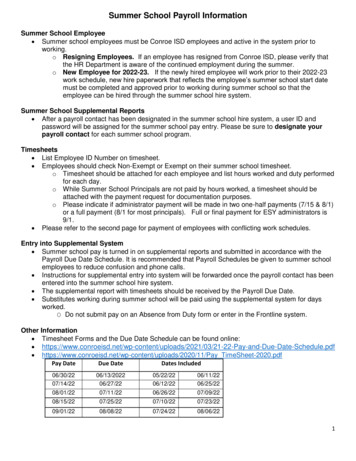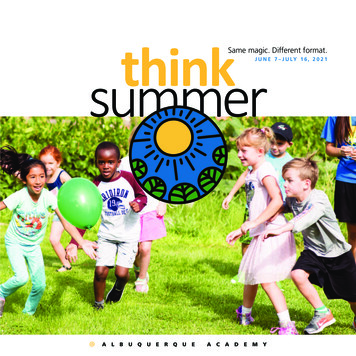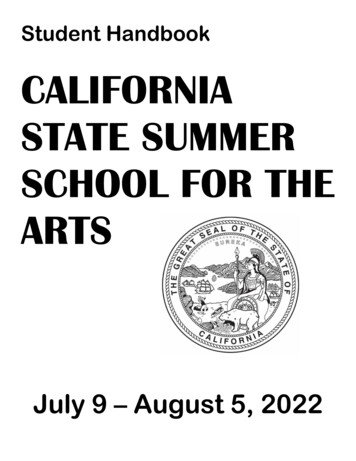
Transcription
Student HandbookCALIFORNIASTATE SUMMERSCHOOL FOR THEARTSJuly 9 – August 5, 2022
CSSSA S U M M E R OFFICEMON-FRI8:30 AM-5:00 PMSATURDAY9:30 AM-3:00 PMSUNDAYCLOSEDCSSSA Main Office*(661) 291-3089comments@csssa.ca.govCampus Safety*(661) 222-2702*For use July 5 – August 5, 2022 only
California State Summer School for the Artsat CalArts 2022CSSSA Executive OfficeClarice Cast, Student AffairsMichele Garcia, Creative Program EngineerKatrina Dolenga, Deputy DirectorMatthew Gallagher, DirectorEric Herrera, CSSSA PhotographerRicci Hidalgo, Administrative CoordinatorBetsy Hunt, Student AffairsKadi Lee, On Call PersonnelZach ‘Attack’ Moser, Recreation DirectorAdrienne Pearson, On Call PersonnelJohn Robinson, Student AffairsCounseling OfficeMelissa Shepherd, CounselorDepartment ChairsKati Angelov, AnimationShari Bond, Visual ArtsHilary Darling, WritingB.J. Dodge, Theater ArtsKirsten Roberts, DanceJose Soto, MusicFrederick Thornton, FilmFood ServicesDianna Sherick, General ManagerResidence Life OfficeBethany Ponek, Associate Director
TABLE OF CONTENTSPAGE NO.SECTION I: California State SummerSchool for the Arts1-4SECTION II: California Institute of the Arts (CalArts)California Institute of the ArtsHow to Get There44-5SECTION III: College Credit5-6SECTION IV: Rules and Policies of the CSSSARules and PoliciesDisciplinary ActionAlcohol and DrugsWeaponsGraffitiProhibited AreasSexual HarassmentSmokingVehiclesLeaving CampusCampus VisitorsClass ParticipationCell Phones, Computer and ElectronicsShoes and ShirtsI.D. CardsPossessionsMeal Time AttendanceRefundsCopyright Ownership and Registration6 - 168-99999 - 1010 - 11111112 - 1313131414141414 - 151515 - 16SECTION V: Residential LifeResidential LifeRules Regarding Living in Residence HallsResident AssistantsResidence Life OfficeNight DutyRoom and Roommate AssignmentQuiet HoursKeysCleaningDorm DamagesRepairs and MaintenanceRecycling & Water ConservationCurfew and Room CheckLights OutReligious Services16 - 2116 - 1818181919192020202020212121i
TABLE OF CONTENTSPAGE NO.SECTION V: Residential Life Cont’d.Shopping (Vista Village and Valencia Marketplace)Food DeliveryMailMessagesLaundry RoomsFaculty Housing21 - 222222222223SECTION VI: What to BringYou Should BringYou Should Not BringClothingSpending Money23 - 24232424SECTION VII: Resources/AssistanceHealth ServicesPrescription MedicationsEmergenciesMediationLost and FoundLibrary24 - 262525262626SECTION VIII: RecreationRecreationPool Area26 - 2726 - 27SECTION IX: Power OutagesPower Outages27SECTION X: Campus Security and SafetyEmergency CommunicationsPrecautionary MeasuresEarthquake/Disaster Preparedness and Survival GuideEvacuation Procedures27 - 282828 - 2929SECTION Y: 2022 COVID – 19 ProtocolsCovid – 19 Protocols30 - 31Campus MapInside Back Coverii
SECTION I: California State Summer School for the ArtsTHE CALIFORNIA STATE SUMMER SCHOOL FOR THE ARTSHISTORYIn the early 1980's California was facing increased competition from other states for its thirdlargest source of tax revenue, the arts and entertainment industries. Film, television andrecording studio complexes, which had been traditionally developed in California, were beingbuilt in Florida, Texas, and other locales. Motion picture industry executives and producerswere increasingly looking outside of the state for production opportunities. Many ofCalifornia's non-profit fine arts institutions, and the state's educational community, were feelingthe effects of a diminishing interest in California from the commercial arts sector.In 1982, a three-year effort to establish an educational environment for young California artistsbegan. Legislation sponsored by former State Senator Alan Sieroty launched a planningprocess. A twenty-four member Advisory Council of legislative, arts, and industry leaders wasappointed by the California Arts Council and the State Board of Education to explore the causeof the talent drain, and to recommend statewide educational opportunities. One of theproblems the Council discovered was that many of California's most talented young artists andentertainers were leaving the state to attend arts training programs in New York, NorthCarolina, Michigan, and other states -- and staying on to live and work where they went toschool.The work of the committee culminated on September 28, 1985, when Governor Deukmejiansigned the bill, authored by State Senator John Garamendi, which created the California StateSummer School for the Arts. The major objectives stated by the Legislature in establishingCSSSA: To enable artistically gifted and talented students, broadly representative of thesocioeconomic and ethnic diversity of the state, to receive intensive training in the artsthrough a multidisciplinary program; To provide a training ground for future artists who may wish to study and practice the artsor to pursue careers in the major performing arts companies and the commercial and finearts institutions in California; To establish a model for partnership between the public and private sectors.The program proved so popular and successful that Governor Deukmejian signed follow-uplegislation in September of 1990 making CSSSA a permanent program of the state. In 1992,Governor Pete Wilson signed legislation that enables CSSSA to accept a limited number ofstudents from outside of California, thereby making it a national program.CSSSA is the result of unique public and private sector planning and support. Now embarkingon its thirty-sixth summer of operation, CSSSA has trained more than fifteen thousand highlytalented alumni.1
SECTION I: California State Summer School for the Arts Contd.MISSIONThe mission of CSSSA is to annually provide a select number of California high school studentsof the visual, literary, performing and media arts with an intensive learning experienceconducted by distinguished arts professionals, designed to enhance the students' artistic skillsand to develop their understanding as individuals of their potential for growth as creativeartists.By fulfilling its mission CSSSA will: Provide recognition, distinction and professional training in the arts to a broadly recruitedstudent body of talented high school students in a scope and manner not availableanywhere else in California. Establish an educational community of professional artists and talented students that offersopportunities for creative risk taking, imaginative discipline, critical thinking, collaborativeproblem solving and leadership. Ensure that the school's student body, faculty and curriculum are reflective and sensitive toCalifornia's diverse cultural heritage. Support and encourage each student's singular capacity for creative accomplishment. Provide an educational link with institutions of higher learning, major performing artscompanies, commercial and fine arts institutions, and the film, television and recordingindustries in California for students wishing to pursue careers in the arts. Establish models for excellence in arts education and direct attention to the need for highquality arts programs in all California schools. Enhance the overall cultural climate of California by training future artists, who willcontribute to and become advocates for the arts. Help to ensure the long-term development of artists for the arts and entertainmentindustries, which currently comprise California’s second largest business sector. Position California, home to 20% of America's artists, as a leader in striving for excellence inthe arts.It is our expectation that some CSSSA graduates will become professional artists. Others will goon to apply their creative skills in other professions. The goal of CSSSA is to provide aneducational experience that goes beyond the practice and improvement of aesthetics andtechnique. We want to broaden our students' understanding of their creative potentials,regardless of their eventual life paths.STUDENTSThe school is open to students from all of the public and private secondary schools inCalifornia. In addition, CSSSA may accept up to twenty students per year from outside of2
SECTION I: California State Summer School for the Arts Contd.California. The sole criteria for admission are an applicant's potential for professionaldevelopment as demonstrated through audition, portfolio review, screening and teacherrecommendations regarding their demonstrated motivation and discipline. The CSSSAadmission process is "needs blind", that is, no applicant is denied entrance solely on the basis ofinability to pay. The CSSSA student body is broadly representative of the wide economic,cultural and ethnic diversity of the state.The young artists who attend the CSSSA program are designated "California Arts Scholars,”which is the highest distinction in California for artistically talented students.SITEEach summer's four-week residential program takes place at a site chosen, through competition,by the school's Board of Trustees. The California Institute of the Arts will host the 2022 summersession.FACULTYThe CSSSA faculty is composed of professional artists and arts educators in the seven artisticdisciplines taught at the school: animation, dance, film, music, theater, visual arts, and writing.Faculty members are selected on the basis of artistic excellence in their art forms as well as theirteaching abilities.FUNDINGFunding for the California State Summer School for the Arts is provided through a uniquepublic/private partnership. By law the school must obtain a portion of its funding from nonstate sources. The California State Summer School Arts Foundation was founded in 1986 toseek gifts from corporations, foundations and individuals.Herb Alpert Scholarships for Emerging Young ArtistsCSSSA will be able to help some of its students with college aid through the distribution ofHerb Alpert Scholarships for Emerging Young Artists. By agreement between CSSSA and theHerb Alpert Foundation, twenty-one students each year will be designated Scholarshiprecipients. The Herb Alpert Scholarships for Emerging Young Artists include three awards ineach of seven categories: Animation, Film, Dance, Music, Theater, Visual Arts, and Writing. Ineach category, two students will receive single-year awards of 2,500, and one outstandingstudent will receive up to 40,000 to be awarded in equal installments of 10,000 over the courseof four years.During the fourth week of the 2022 session, CSSSA department faculties will choose awardrecipients from enrolled CSSSA students. The CSSSA application serves as the initialapplication for this CSSSA-exclusive college scholarship. The selection criteria used by thefaculty in each department will include a balanced assessment of artistic talent, character andmotivation, likeliness of success in a collegiate or professional training program, and financialneed.3
SECTION I: California State Summer School for the Arts Contd.CSSSA's supporting organization, the CSSSA Foundation, administers all scholarships. TheCSSSA Foundation provides the top seven scholarship recipients with professional financial aidconsulting and coordination to assure that the Herb Alpert Scholarship will be used to offset thework and loan burdens the student would otherwise be expected to carry, and will not supplantother resources that should be provided by the financial aid offices of the colleges they chooseto attend.The CSSSA Foundation may share aggregate information on grant recipients as part of its grantreporting. These grantor reports will not reveal information that can directly identify anindividual and the CSSSA Foundation will never sell or give information to an unrelated thirdparty.CSSSA and the CSSSA Foundation have a strong partnership with theHerb Alpert Foundation, which has provided CSSSA alums with more than 3 million dollarsin scholarships since 2008.SECTION II: California Institute of the ArtsCALARTSThe California Institute of the Arts (CalArts) was incorporated in 1961 as the first fullyaccredited, degree-granting institution of higher learning in the United States specifically forstudents of the Visual and Performing Arts. The Institute was established through the visionand generosity of Walt Disney and the merger of two well-established professional schools, theLos Angeles Conservatory of Music, founded in 1883, and Chouinard Art Institute, founded in1921. By 1971, degree programs in dance, film, and theater had been added to art andmusic. In November of that year, CalArts (the popular name for the Institute) moved to itspermanent site in Valencia.The campus occupies 60 acres on hills overlooking the Santa Clarita Valley, an area historicallydevoted to agriculture and cattle ranching. During the past 25 years, Los Angeles has expandednorthward into the area. The main building on campus is a five level multi-winged structure ofa half-million square feet. It houses art studios, electronic music studios, dance spaces,rehearsal rooms, theaters, costume, scenery and machine shops, galleries, editing rooms, soundand video stages, and the library and cafeteria.Chouinard Hall, the student residence facility, will accommodate all of the students of theCSSSA class of 2022. Tennis courts and a large swimming pool are located adjacent to thefacility. Spacious lawns with shade trees, open fields and large hillside areas provide room forinformal team sports and relaxation. The climate is typical of lower desert valleys withtemperatures sometimes exceeding 100 degrees during the month of July. All campus facilitiesare air-conditioned.HOW TO GET THERECAR: The CalArts Campus is located at 24700 McBean Parkway in Valencia, a residentialneighborhood north of Los Angeles, California. If driving, take Interstate 5 to the McBeanParkway exit and head east on McBean Parkway. The campus entrance is on the immediateright. Signs and campus personnel will direct you to the student registration area.4
SECTION II: California Institute of the Arts Contd.AIR:Burbank Airport: The most accessible airport is the Hollywood Burbank Airport, which isserviced by most major airlines. The airport is approximately 25 miles south of Valencia. CSSSAwill provide the following shuttle services to and from the Burbank Airport ONLY:SHUTTLE DEPARTURE TIMESJuly 9th:August 5th:11:00 a.m. and 1:00 p.m.2:00 p.m. ONLYThe cost of this shuttle is 40 payable in cash upon arrival on July 9th. The cost for a one-wayshuttle is 20. Please reserve your space early by e-mailing CSSSA with your FLIGHTNUMBER and TIME OF ARRIVAL/DEPARTURE. The shuttle is for students only and spacewill be limited – e-mail no later than June 10th (comments@csssa.ca.gov). CSSSA Staff willmeet students at baggage claim. A roundtrip shuttle reservation will not be made until botharrival AND departure flight information are received. A confirmation e-mail will be sent. Ifyou have questions on July 9th, please contact the CalArts safety office (661-255-1050, extension2112) and they will get a message to the CSSSA Administration immediately.Travel Suggestion: If you are planning to utilize the shuttle services provided by CSSSA, weSTRONGLY recommend that return flights on August 5th NOT be scheduled before 4 p.m. Theshuttle departs the campus at 2:00 p.m. and will deliver students to the airport—you mustallow time for traffic and airport check-in.Airport Shuttle Services: Prime Time Shuttle (800-733-8267) offers shuttle service from the LosAngeles International and Hollywood Burbank Airports. Rideshare services, such as Uber andLyft, are permitted on campus July 9th and August 5th only.Please Note: Registration Day, July 9th, is mandatory for all students. Check-in time onSaturday, July 9th is between 9:00 a.m. and 4:00 p.m. Registration will close at 4:00 p.m. Parkin the main lot and follow the signs to CSSSA registration. Checkout time is on Friday,August 5th between 1:00 pm and no later than 6:00 p.m.—absolutely no exceptions.SECTION III: College CreditCOLLEGE CREDITStudents who successfully complete the California State Summer School for the Arts programare eligible to receive three semester units of California State University course credit throughthe Office of Extended Education at Humboldt State University. These credits can be used aselective units towards a Bachelor’s degree at any of the campuses in the California StateUniversity system. They are also generally transferable to other colleges and universitiesthroughout the United States. (Students should consult with the college or university they planto attend, as each institution has specific guidelines for transferring college credit.) CSSSA doesnot assign letter grades. Students eligible for credit will receive “credit” or “no credit”. Studentswho, in the collective opinion of their instructors, have satisfactorily completed theirdepartmental programs will receive a grade of “Credit”.5
SECTION III: College Credit Contd.Registration and Fee: Every student who has accepted admission to CSSSA and whosuccessfully completes* this program in 2022 is eligible for credit. A registration form will be emailed to all students upon successful completion of the program. To apply for the credits,students must send a completed registration form along with payment in the amount of 60.00to the College of Extended Education & Global Engagement at Cal Poly Humboldt University.The registration form and payment must be submitted by December 12, 2022.*Each CSSSA department has specific requirements in terms of class performance, assignmentcompletion, attendance and behavior, which must be met in order for a student to receive agrade of “Credit”. These requirements will be described in full by the Chairperson of eachdepartment during the program orientation meetings, which will be held at the beginning of theCSSSA session. It is the student’s responsibility to keep informed of his or her progress in theclasses. Failure to meet the requirements will result in a grade of “No Credit”.SECTION IV: Rules and Policies of CSSSARULES AND POLICIES OF CSSSAWhen you arrive at CalArts, you are joining a community. In any community, a certain amountof organization and structure is required. This structure protects the program, the rights of theindividual, and promotes community spirit and cooperation. Rules have been developed toconform to accepted standards of social and residential life behavior, existing laws and commonsense. CalArts and CSSSA reserve the right to have its authorized agents or employees enterstudent rooms at any time, without prior notice or permission, to investigate when a reason tosuspect that violation of CSSSA and/or CalArts’ policies may be occurring. Please conductyourself with appropriate respect for other individuals' rights and properties. You representCSSSA at all times. It is imperative that all students know the following rules and policies asviolation of any of the below may result in immediate expulsion without warnings:(1)Use, possession or knowingly being in the presence of others who are using or possessvape pens, or any device that could be classified as an e-cigarette, tobacco, nicotine,drugs, drug paraphernalia, alcohol or any other illegal substances(2)Use, possession or in the presence of lighters, matches or other objects used to producean open flame (FYI, the CalArts campus is located in a high fire danger area)(3)Inability to function adequately in the program for any reason (such as lack of sleep,prolonged illness, panic attacks, anxiety, mental instability or improper eating habits)(4)Neglecting or refusing to take prescription medications as outlined on page 25—readcarefully(5)Sharing personal prescription medication and/or taking prescription medication notprescribed to you is prohibited and grounds for expulsion(6)Plagiarizing is prohibited and grounds for immediate expulsion6
SECTION IV: Rules and Policies of CSSSA Contd.(7)Receiving or giving body piercing is prohibited at CSSSA(8)Receiving or giving tattoos is prohibited at CSSSA(9)Clothing must be modest. Shorts should be no shorter than 8 inches above the knee.Tops must cover the stomach (no crop tops). Bathing suits may be worn only inside thepool area. Clothing with inappropriate language or offensive messaging is prohibited.Students wearing inappropriate clothing will be warned. Upon the 3rd warning, thestudent will be asked to leave the program.(10)Possession, use, or discharge of a weapon, real or toy, including but not limited to guns,knives, blades, Exacto knives, etc.(11)Use or possession of aerosols, room deodorizers, flushing wipes or cleaning supplies(12)Sexual harassment (described in detail on pages 10-11)—read carefully(13)Physical violence, intimidation, verbal abuse, threats, bullying or harassment directedtowards any CSSSA or CalArts student, teacher or staff member(14)Vandalism(15)Graffiti is only allowed in designated areas of the sublevel. Hate messages will bereported as a hate crime and result in automatic expulsion(16)Damage or theft of possessions of fellow students, staff or property of CSSSA or CalArts(17)Involvement in any illegal action(18)Leaving the CalArts campus during unauthorized hours without written permission(19)Missing students resulting in CSSSA contacting the local authorities(20)Entering or leaving residence halls or assigned room after curfew hours and before 6:00a.m.(21)Inviting non-CSSSA persons into the residence halls(22)Maintaining or using a car during the program(23)Upon the 3rd class missed, you will be ineligible for college credits and asked to leave atthe Director or designee’s discretion. There are no excused absences(24)Repeated and multiple infractions of the residence hall rules as outlined on pages 16 - 21(25)Disruption of classes, performances or other school activities will result in immediateexpulsion*Informing Student Affairs of others breaking these rules will not jeopardize your status atCSSSA.7
SECTION IV: Rules and Policies of CSSSA Contd.Special Note to CSSSA students who are 18 years old or older and their parents: When youaccept the offer of admission to CSSSA, you agree to abide by all of CSSSA’s Rules andPolicies despite the fact that these may be more restrictive than you are accustomed to inyour home environment. This includes the Rules and Policies pertaining to Vehicles (page11), Leaving the Campus (pages 12-13), Curfew and Room Check (page 21) and PrescriptionMedications (page 26). All CSSSA students are expected to adhere to these rules.Disciplinary ActionStudents participating in the CSSSA program are expected to conduct themselves in a mannerappropriate to living on campus. Disciplinary action in response to infractions of the CSSSArules is left to the discretion of the school, which reserves the right to take all actions it considersto be in the best interest of the student, the student body and the school. Should any student'sbehavior violate any of the CSSSA rules, formal disciplinary action may occur as follows withthe CSSSA Director or his designee maintaining complete discretionary power to determinewhether parental notification, early curfew, probation and/or immediate expulsion iswarranted:(1) RESIDENCE LIFE INFRACTIONS: The Residence Life Office and the residentassistants are responsible for enforcing all dormitory rules. In the event of an infractionthe Director of Residence Life or designated agent may take the following actions: earlycurfew, probation, parental notification, referral to CSSSA staff for further action and inextreme cases, sheriff notification and eviction from the dorm and expulsion from theprogram. NOTE: ALL DORM DISCIPLINARY INFORMATION IS SHARED WITHCSSSA DIRECTOR AND STAFF. (See Rules Regarding Living in the Residence Hallsstarting on page 16.)(2) CLASSROOM INFRACTIONS: Any student who, in the opinion of the academicdepartment chairperson, has seriously breached the rules and expectations of thatdepartment regarding handling of equipment and materials, the privacy and rights ofother students, or participation in inappropriate classroom behavior, may be expelledfrom CSSSA upon the first infraction without warning. Furthermore, any student notcompleting assignments and/or meeting class academic standards will be reported tothe administration and may be subject to expulsion.(3) ALL OTHER INFRACTIONS: All other infractions will be handled by CSSSADirector or designee. The student's actions will be documented in writing and CSSSAadministrators will be informed of the infraction. The student will be scheduled for ameeting with CSSSA Student Affairs. After ascertaining the facts of the situation, CSSSAwill determine whether parental notification, early curfew, probation and/or expulsionare warranted.(4) EXPULSION FROM CSSSA: In the event of an expulsion, the student's parents orguardian will be contacted to make arrangements for the student's return home on thesame day of expulsion. No expelled student may reside on campus. A dismissal letter8
SECTION IV: Rules and Policies of CSSSA Contd.indicating the cause of expulsion may be sent to the student's high school. Expulsion isat the absolute discretion of the CSSSA Administration. NO REFUND of fees or awardof college credit will be made to a student who has been expelled from CSSSA.Alcohol and DrugsThe CSSSA Board of Trustees and staff feel strongly that substance abuse is a significantlydangerous threat to our society and to the health and well being of artists, writers andperformers.As a state agency, CSSSA is obliged to observe all federal, state and local laws and ordinances.As stipulated in the preceding section, any student whose behavior or conduct subverts orviolates any law regarding alcoholic beverages, drugs or controlled substances, will beimmediately expelled from the school. This includes students who, in the opinion of theadministration, are knowingly in the presence of those using or possessing alcohol or drugs andfail to report this to the administration. Additionally, the school will cooperate fully with anylaw enforcement or governmental agency in the prosecution of any violations of existingstatutes regarding controlled substances or alcoholic beverages.MarijuanaPossession of marijuana in any form is strictly prohibited at CSSSA. If you have aprescription for marijuana, you must discuss your alternatives with your health care provider inadvance of your arrival on the CalArts Campus. You are not allowed to bring any form ofmarijuana to CSSSA. CSSSA and CalArts reserves the right to have its authorized agents oremployees enter the premises and/or student’s room at any time, without prior permission, toinvestigate when a reason to suspect that a violation of CSSSA and/or CalArts policies may beoccurring. If marijuana is found in your possession, prescription or otherwise, you will beexpelled immediately.WeaponsPossession of a weapon (real or toy) in a public school is a violation of state law. Any weaponsfound on campus will be confiscated and turned in to the local police. ANY STUDENTFOUND IN POSSESSION OF A WEAPON WILL BE IMMEDIATELY REPORTED TO THELOCAL POLICE AND WILL BE EXPELLED FROM CSSSA.GraffitiThe marking or tagging of any surface anywhere on the CalArts campus outside of thedesignated areas of the sub-level in the Main Building will be considered vandalism andgrounds for expulsion. CSSSA students may not paint, mark or in any way deface floors,ceilings, doorframes, doors, and door hardware in the sub-level. Spray paints and otherhazardous/toxic materials are prohibited. Message of hate will be considered hate crimes thatwill be reported. Students responsible will be expelled.Prohibited AreasFor the safety of all, CSSSA has designated campus areas that are prohibited to students.Students found in these tall grassy areas will receive early curfew. Repeat offenders will be9
SECTION IV: Rules and Policies of CSSSA Contd.subject to expulsion. Prohibited Areas include: Fire Valley, slope behind Ahmanson Hall andthe wooded area above the soccer field. See map on inside back cover of the handbook or stopby the CSSSA office if you need clarification.Students are never allowed into CalArts private studios. Students found in private studios willbe reported and subject to expulsion. See campus map on the back cover for prohibited areas.Students may only access spaces designated for their particular department unless approved bythe administration or department chairperson.Sexual HarassmentCSSSA has zero tolerance for sexual harassment. Sexual harassment is generally defined asunsolicited and unwelcome sexual advances of a severe and/or pervasive nature, whetherwritten, verbal, physical or visual. It is different from flirting, playing around, or other types ofbehavior that you enjoy or welcome. Sexual harassment can be requests for sexual favors orunwelcome sexual behavior that is bad enough or happens often enough to make you feeluncomfortable, scared, or confused and that interferes with your schoolwork or your ability toparticipate in extracurricular activities or attend classes. Examples of harassment prohibited bythis policy may include, but are not limited to: verbal conduct (comments about your body,spreading sexual rumors, sexual remarks or accusations, unwanted advances, unwantedpropositions of a sexual nature, dirty jokes or stories); physical conduct (grabbing, rubbing,flashing or mooning, touching, pinching in a sexual way, intentionally blocking normalmovement, sexual assault and rape); and visual displays ((display of naked pictures or sexrelated objects, obscene gestures). Sexual harassment can happen to girls and boys. Sexualharassers can be fellow students, teachers, principals, janitors, coaches, and other schoolofficials.There are two kinds of sexual harassment: quid pro quo and hostile environment: Quid pro quo (in Latin it means “this for that”) sexual harassment occurs when ateacher or school employee offers you a better grade or treats you better if you dosomething sexual. It could also be a thre
The California Institute of the Arts will host the 2022 summer session. FACULTY The CSSSA faculty is composed of professional artists and arts educators in the seven artistic disciplines taught at the school: animation, dance, film, music, theater, visual arts, and writing.
